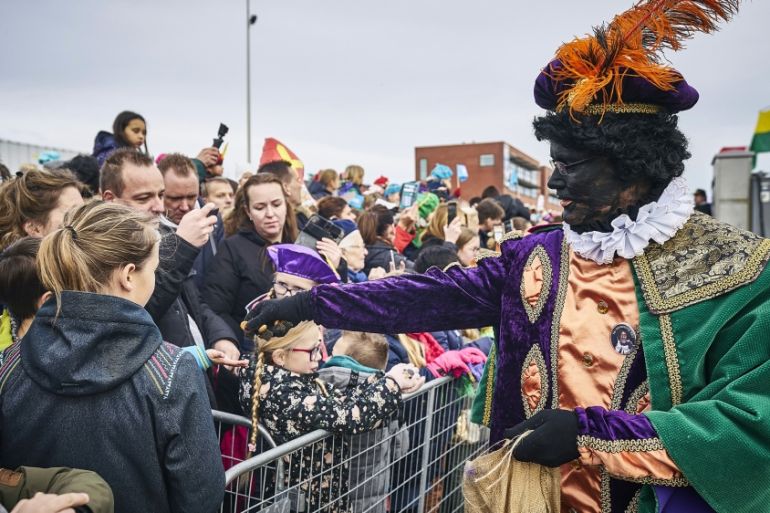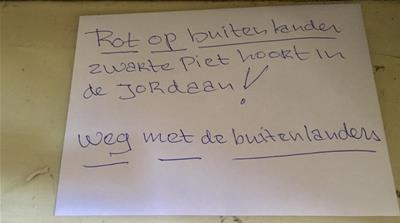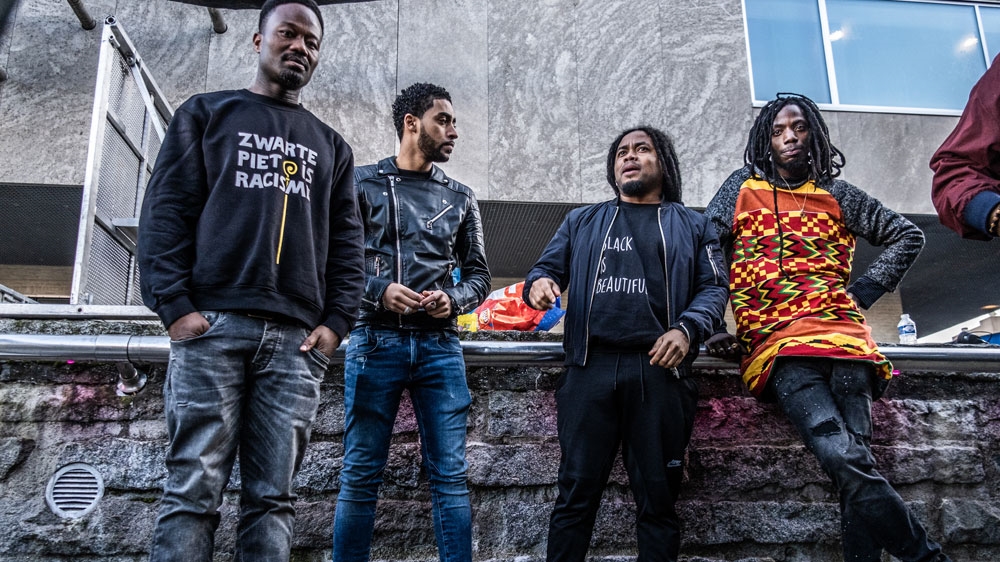Black Pete: Blackface character stirs debate during Dutch holiday
Having caught the attention of celebrity Kim Kardashian, renewed debate over racism during Sinterklaas festival.

Amsterdam, the Netherlands – In Amsterdam’s traditional and now trendy Jordaan neighbourhood, a house is bedecked with the festive holiday trappings of Sinterklaas, the annual Dutch holiday.
More than a dozen blackface dolls are affixed to the facade. Across the street, a large white sheet hangs outside another house with a painted message in blue: Zwarte Piet is Racisme.
Keep reading
list of 1 itemThe battle over the divisive Dutch holiday character Zwarte Piet, or Black Pete, is on full display again this year.
While Sinterklaas, based on the historical figure of Saint Nicholas, is portrayed as an elderly white man who arrives by ship and rides a white horse in parades across the Netherlands, hundreds of adults and children dress up as his helper, Zwarte Piet, wearing blackface, painted large red lips and black curly wigs, some with large golden earrings.
With often buffoonish behaviour, the depiction is considered by many to be a vestige of a racist past, originating in the minstrel shows in the eighteenth-century United States.
“It’s the culture and tradition, but very quickly it becomes xenophobic and the conversation isn’t even allowed, it’s just racism,” said a student living in the house with the protest sign, who requested anonymity.
She describes herself as one of the only people of colour living in the hofje – traditional Dutch housing built around a courtyard.
Recently, someone handed her a written note that said: “P*** off foreigner, Black Pete belongs in the Jordaan! Away with the foreigners.”

While Amsterdam is a liberal Dutch city, the Jordaan neighbourhood is a microcosm of the country’s conflict over this festival.
“I was against Black Pete since I was nine, of course, it has to change and is racist, but the conflict about Black Pete is a problem,” said a 62-year-old man, who also requested anonymity. “I’m a vegetarian, if I lived opposite Muslim or Jews and I wrote ‘Eating kosher meat is sadism’, does that change the world in a positive way? This approach gets people really angry against black people.”
A woman from the north of the country, who works as an au pair several days a week in Amsterdam, said: “I grew up with this and it is cultural and I like it. I don’t believe it is racist.
“As a child, I had Black Pete and Sinterklaas, so why can’t we have it now? I don’t understand it.”
When asked, as it has been suggested, if it would be better to change the character to Chimney Pete, a face covered with only a few specks of soot because full blackface is offensive, she said: “But that is not the tradition. I don’t like that.”
The racism associated with Black Pete impacts adults and children. There have been many documented cases of both being harassed and called Black Pete.
Fans at a football matches have used Black Pete as a slur against black players.
“You get people telling you, ‘You don’t have to paint your face because you are already black, you already look like Black Pete,'” said Ramone Bendt, an 18-year-old medical student.
“When someone gets angry, they go to the term Black Pete to insult you, you get called it when you are young, and you don’t know why it hurts you. You think you are the only one experiencing it, and then you hear other people experiencing the same thing.
“You can see a lot of Dutch people saying how tired they are of hearing about racism, and I always say: ‘Imagine how tired we are of experiencing it.'”
Black voices in the Netherlands mean nothing to the establishment. That's why sometimes we need people from abroad to really stand with us.
Much of the public conversation in the Netherlands over the past month was sparked by Bendt’s post on November 10 to a Facebook group Ladies Talk, a group of 30,000 Dutch women and gay men, after an attack on the group Kick Out Zwarte Piet, who were meeting to discuss racism in The Hague.
More than 40 hooligans tried to break into the building where the meeting was being held. They threw fireworks and vandalised cars outside. Several were arrested.
Ramone’s post included a link to an article these reporters wrote about Black Pete for Al Jazeera last year. It was sent by members of the Facebook group to musicians and influencers around the world. The article went viral after it was retweeted by Kim Kardashian and Waka Flocka Flame.
“A lot of people get mad when it gets exposed outside because when the story stays national, the pro-Peters easily know how to brush it off,” said Jerry Afriyie, who co-founded the Zwarte Piet is Racism movement in 2011.
“In the Netherlands, we are the minority, but when it becomes international, they are the minority.”
Meanwhile, Ramone has been attacked online, with some calling her a “black w****”.
'At first, they say Black Pete is a tradition, then it quickly ends up with, 'Leave the country, go back to where you came from.''
At the Back to Black coffee shop in Amsterdam, Nilab Ahmadi, 27, a law student said Black Pete exposes hidden racism.
“The first misconception is that Holland is a tolerant country; that has been said often, which hides the fact that it is really not. The discussion about Black Pete often unravels. At first, they say Black Pete is a tradition, then it quickly ends up with, ‘Leave the country, go back to where you came from.'”
“The Netherlands have always been rich and thrived through colonialism, and they have a sense of privilege and think you can’t interfere with what they do, or any habit they have in the name of racism. There is a sentiment that anyone who comes here has to abide by our rules and traditions and we don’t have to change anything.”
Ahmadi grew up thinking the Black Pete tradition was “weird and a bit scary”.
“If he comes from the chimney, why does he have curly hair and red lips?”
Perle, 28, from Eindhoven, has experienced first-hand the racist backlash to challenging Black Pete.
This Dutch “tradition” called: “black pete” is disturbing! https://t.co/fF26SP99OT
— Kim Kardashian West (@KimKardashian) November 17, 2019
At a rally against Black Pete last year, she was pushed and shoved by pro-Pete thugs and called racist slurs, which was captured in a video that went viral.
She was heartened this year when her son’s school responded to her concerns, cancelling blackface Pete and putting forth different options, including a Rainbow Pete.
However, she was recently harassed and threatened on the street by a man who recognised her, accusing her of “ruining my tradition” and telling her to “go back to your own country”.
Afriyie believes the country has reached a turning point.
Dutch broadcaster NTR airs the parade held in honour of Sinterklaas’s arrival and Sinterklaasjournal, a daily show of Sinterklaas and Black Pete travelling across the Netherlands.
“This year was the first in history where the national broadcaster decided they were not going to have a Black Pete on the show; it was a historical moment. They replaced Black Pete with Chimney Pete, so that is the biggest accomplishment until now, because now millions of children are no longer seeing a caricature of a black person.”

Still, Prime Minister Rutte has not spoken with his group, nor has he condemned the attacks against them.
“The prime minister has talked with all groups who protest, including the yellow vests, he has talked with them twice, but he hasn’t talked with us.”
Afriyie is still concerned about rising violence. The police have notified him about threats to his safety, including receiving a photo of his face alongside a bullet. But he remains optimistic, focusing on educating the next generation.
“Black voices in the Netherlands mean nothing to the establishment,” he said. “That’s why sometimes we need people from abroad to really stand with us.”